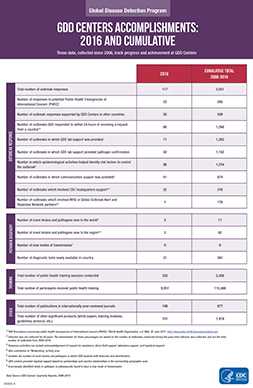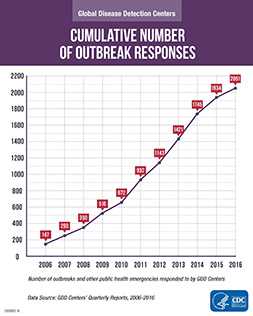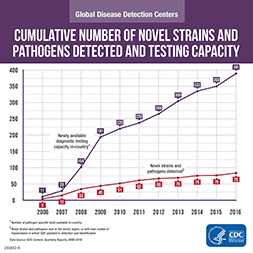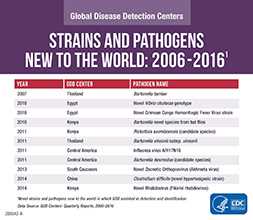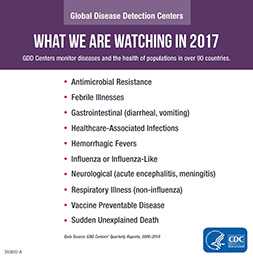Global Disease Detection Program: What We Do
Beginning in 2006, the Global Disease Detection (GDD) program began routinely monitoring the program’s capabilities and progress. The data collected is used to track progress and achievement at GDD Centers. This helps the program continuously improve as we identify areas of need and opportunities to provide additional technical assistance.
What We Measure
Our measures are related to the following five key activities:
- Outbreak Response: Improving the timeliness and reliability of outbreak investigations and responses
- Pathogen Discovery: Advancing public health knowledge through innovative research into the epidemiology and biology of emerging infections and through identifying novel threats before they spread
- Training: Building capacity and improving the quality of epidemiology and laboratory science through training
- Surveillance: Strengthening surveillance systems that are capable of detecting, assessing, and monitoring the occurrence and public health significance of infectious disease threats over time
- Networking: Enhancing collaboration through shared resources and partnerships
Measurements from 2006-2016
Outbreak Response
We ensure outbreak investigations and responses are timely and comprehensive.
What We Did
- Responded to more than 2,000 disease outbreaks and other public health emergencies, including:
- Ebola in Guinea, Liberia, and Sierra Leone (all GDD Centers)
- Anthrax (Bangladesh)
- Chikungunya (Central America)
- Influenza H7N9 (China)
- Human H5N1 influenza (Egypt and Thailand)
- Acute encephalitis syndrome (India)
- Botulism (Kazakhstan)
- Cholera (Kenya)
- Novel orthopoxvirus (South Caucasus)
- Provided fast response: About 2/3 of outbreaks received a response within 24 hours of the request for assistance
- Responded comprehensively: 67% of outbreaks involved laboratory support. Of those, 85% were given a confirmed cause
Pathogen Discovery
We identify novel threats before they spread and advance public health knowledge through innovative research into the epidemiology and biology of emerging infections.
What We Did
- Established over 380 newly available in-country diagnostic tests in 59 countries, improving disease detection capability and contributing to faster response times
- Detected and identified 11 novel strains and pathogens that were identified for the first time anywhere in the world
- Detected and identified 62 novel strains and pathogens that were new to the region in which they were discovered
Training
We build capacity and improve the quality of epidemiology and laboratory science through applied training.
What We Did
- Provided a more robust scientific curriculum and training program for epidemiologists and laboratorians by integrating several programs into one platform
- Increased the number of FETP-trained epidemiologists and laboratorians within GDD Center regions
- Provided short-term public health training to nearly 100,000 participants worldwide. Training topics have included epidemiology, laboratory, all-hazards preparedness, risk communication, influenza, and others
Surveillance
We strengthen surveillance systems capable of detecting, assessing, and monitoring the occurrence and public health significance of infectious disease threats.
What We Did
- Conducted disease surveillance in over 90 countries
- Participated in network-based projects as part of a CDC-wide infectious disease surveillance and research system that extends to multiple sites across the globe
- Used surveillance data to detect outbreaks, make policy recommendations, evaluate new interventions, and measure public health impact
- Surveillance data has informed and influenced policy decisions in country. For example, in Thailand, our GDD Center provided information on the burden of influenza and helped make the case for increased use of flu vaccine, which led Thailand to invest $97 million into its influenza programs
Building Network Capacity
We enhance collaboration through shared resources and cooperation.
What We Did
- Worked with WHO and local ministries of health to control the spread of respiratory infections in healthcare settings
- Collaborated with WHO and other partners to assess the ability of countries to meet the revised International Health Regulations (IHR)
- All of our Centers support global health security, helping countries build the ability to prevent, detect, and respond to infectious disease threats. Six of our centers (Bangladesh, Kenya, Thailand, India, Georgia, and Kazakhstan) are located in countries that have been named U.S. partner countries on the Global Health Security Agenda
References
- U.S. Centers for Disease Control and Protection. Global Disease Detection Program: Monitoring and Evaluation Report 2009 [3 MB, 32 Pages] and Global Disease Detection Program: Monitoring and Evaluation Report 2010 [5.65 MB, 36 Pages]. [accessed June 2017]
- GDD Centers’ Quarterly Reports, 2006-2016.
- Page last reviewed: September 15, 2017
- Page last updated: September 15, 2017
- Content source:


 ShareCompartir
ShareCompartir
